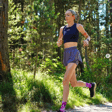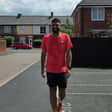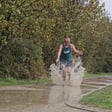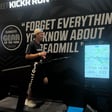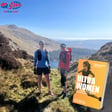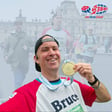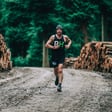Become a Creator today!Start creating today - Share your story with the world!
Start for free
00:00:00
00:00:01

Lucy Hurn
Lucy is a level 3 triathlon coach, personal trainer, sports massage therapist, endurance athlete, and lead run coach at aurofit.
In 2019 Lucy competed at the Worlds and Europeans (Olympic distance) and came 5th in age group at Ironman Austria.
In this episode Lucy tells us about her journey into racing and a career change in to Health & Fitness and amongst other things gives her tips on how to train in a covid world.
You can follow Lucy on @feelfitwithlucy and Auro on @aurofit.
Transcript
Introduction to UK Sportstrap Podcast
00:00:00
Speaker
Hello there, how are you all? Welcome to the UK Sportstrap Podcast, the first of 2021.
Meet Lucy Hearn: Athlete and Coach
00:00:07
Speaker
I'm Joe Williams and on today's show I am speaking with Lucy Hearn.
00:00:12
Speaker
Lucy is a level three triathlon coach, personal trainer, sports massage therapist, endurance athlete, and lead run coach at Aurofit. In 2019, Lucy competed at the Worlds and Europeans, Olympic distance, and came fifth in age group at Ironman Austria. Lucy has hosted a couple of UK Russia hours recently, and will be on again this coming Sunday, the 10th of January on the Auro account, and will be available to take your questions.
00:00:40
Speaker
After my chat with Lucy there is a sample 28 minute body weight legs workout from the Auro app. It's one of the intermediate lower level
00:00:51
Speaker
body workouts for you to hear the kind of audio classes that are available on the app.
Listener Engagement and Feedback
00:00:57
Speaker
If you have any questions about our chat, then please drop us a message on any of our social channels, or you can also give us any comments or feedback on the podcast on info at ukrumchat.co.uk. In the meantime, have a great week and see you again soon. Hi, Lucy. Hey there. Thanks for coming on. How are you?
00:01:21
Speaker
Very well, thank you. How are you? Yeah, very good. Thank you. Very good. So, as I said, I've already done an introduction. Thanks for coming on. Tell us a little bit, let's start by you telling us a little bit about yourself.
00:01:38
Speaker
Oh, I hate that question. So I am a triathlon coach. I'm a run coach and I'm a personal trainer. I think over the last year I've adapted which bit of me I am more of at more times because it's definitely been a year or last year was definitely a year about being flexible in terms of what I offer.
00:01:56
Speaker
and how I work with people. But yeah, my background is, I mean, I was a very normal person working in an office for the most of
Lucy's Journey: From Office to Triathlete
00:02:04
Speaker
my life. And then about 10 years ago, so I'm 40 now or 43 now.
00:02:09
Speaker
So about 10 years ago, I started getting into some running, just did a charity run through work. And then from there, kind of built up, started doing triathlon. And I would say, you know, from the beginning, I was not one of those people that always did sport at school. I was not one of those people who was always training, always kind of hitting, you know, I was never in a school running team or anything like that.
00:02:29
Speaker
but found something that I enjoyed and that I was good at, not amazing at, but that I was good enough to kind of keep me motivated, but more just found something that really I enjoyed doing. I liked the community. I joined my local triathlon club and got into that.
00:02:45
Speaker
you know, the community side of it, the motivation side of it, the proving to yourself what you can do, what you can achieve. And that's kind of been my journey from there. And I, you know, having come from not having that background of sports, I want to support other people who kind of thought, oh, I can't do that. You know, you always go, oh, those people who do marathons, I'd love to do that, but I could never do that. And I kind of want to help people realize that yes, yes, they can.
00:03:08
Speaker
And sometimes they just need a bit of helping hands, normally more motivation and sort of support than actual advice as to what to do. But yeah, along the way. And so from that, I became a personal trainer and then became a triathlon coach.
Running Adventures and Inspirations
00:03:23
Speaker
And here I am now. Cool. Okay. So which charity run did you do? I was doing, it was the Great North run that I did. I started off with a 10K run.
00:03:35
Speaker
We were running, I was working on climate change at the time, campaigning on climate change and for some reasons I can't remember, we had these enormous big cardboard hands, like sort of the size of a body. So you know when most people do a charity run and they've got the little angel wings that are the kind of little, kind of, what do you call it, net wings, really light. I have these enormous person sized cardboard wings on corrugated cardboard.
00:03:58
Speaker
to make these wings at the back of my body to run the Great North Run, which are not very aero for getting through the wind. So that was quite hard. And because it was the first run I'd really done, I massively underestimated my finishing time or overestimate. I ran faster than I had intended. So I spent the whole time overtaking and literally had to give hand signals to pull out of my lane to overtake with these stupid great cardboard wings on my back. Yeah, that's quite a busy race as well. Yeah. Oh, yes.
00:04:28
Speaker
And so did that just ignite a love for you then, did it? Yeah, I think it was a side to myself I hadn't discovered. I loved the side of
00:04:41
Speaker
getting to know myself better of, you know, I remember the first time I did a track session, I didn't realise that people have more than one gear to run in. I kind of always went out on a run. You do that kind of ploddy running as fast as you can for the kind of distance you're going. And then I remember going down to do a track session again with my local triathlon club and just realising there's another gear to it. I could run faster, but then I had to learn to run slower so I could get that balance between the fast runs and the slow runs.
00:05:05
Speaker
just finding there was stuff I just didn't know I could do and kind of that that thing of pushing yourself and it hurts and it's hard but you get that reward you get that adrenaline but also I was going through a not great time in my life at the time and just setting myself those challenges and proving to myself I could do things you know literally starting from that first 5k that first 10k
00:05:26
Speaker
just helped me kind of progress and then seeing the impact that it can have on mental health myself for other people. And that's very topical now in January as well. Just really inspired me and kind of thought, I want this to be more than just something I do, you know, at the weekends, I want this to be something I can help other people to realize what they can achieve and hope that other people can get out of it, what I got out of it. Yeah, great. And so did that then quickly lead on to you doing a triathlon, was that?
00:05:55
Speaker
Yes. Oh, everything gets confused in the midst of time, doesn't it? But yes, I think I did my first triathlon in 2012.
00:06:04
Speaker
And it was not a notable affair, but it was enough that I enjoyed it and then went on and wanted to do more. And I must have joined the Tri Club after that, I think. And then from there, just kind of took it from there. That was a sprint triathlon set, the shortest or main short distance you do, and then just carried on building up from there. Yeah. But when did you realize that you
00:06:29
Speaker
you know, you were good and you'd go for... I mean, you've made it to your age group, haven't you? Yeah, I was on a training camp, which sounds
Qualifying for the GB Team
00:06:39
Speaker
very grand. It's basically an excuse to go and get some sun in the days when you could go on holidays, get some sun and go away with some friends and ride your bike. But I was on a training camp and there was a girl there from a different triathlon club.
00:06:52
Speaker
who just said to me, you know, you're good, you should look into trying out for these things. And I think if somebody doesn't say that to you, and I would say, in my experience, more women as well, we tend not to put ourselves forward for things. We need other people to kind of give us that confidence that we can do things.
00:07:09
Speaker
And she kind of not pushed me hard, but said, you know, you really should give this a go. And sort of from there, I started to look at what the sum of the times were. And the first time I tried to qualify for my age group in triathlon, I was coached by somebody else and didn't get there. I nearly got there, but didn't quite.
00:07:25
Speaker
And then I started self coaching myself and have qualified for the GB team in various different distances ever, ever since then. And, you know, learning from that, that it's so much about consistency and just getting that consistency of training in there. You know, it very much in triathlon and I think in running as well, it very much depends on your age and what, how competitive that age group is. And it's a lot harder in some age groups than others.
00:07:52
Speaker
Um, but I mean, particularly triathlon, it is a very welcoming world and there is a big diversity of opportunities in there.
Exploring the Triathlon World
00:07:59
Speaker
And, you know, I'm in no way a patriotic person at all, but being able to run a race with GB kit on representing your country is a kind of an amazing experience. And I'd really encourage anybody who thinks they might be halfway there, just this year it's all messed up with the application process because I've been in races for a year, but to look into it, whether that's masters running, whether that's, um, age group, triathlon, whatever.
00:08:22
Speaker
Yeah. Cool. So it's interesting you say that. I interviewed Scott Hill. He's the RAF triathlon head coach and he had the same experience. He did his first triathlon and after the event, one of the more experienced triathletes said to him, you're pretty good. You should really have a look at this.
00:08:39
Speaker
And he went on and competed at Kona, so it's interesting that you both have that same, you know, external frame of reference to say, you're good at this. It's nice. It's like you say, it's a welcoming world, isn't it? Yeah, very much so. So have you got a favourite distance and discipline? You've just mentioned Kona. My ultimate goal would always be to qualify for Kona, the world championship.
00:09:06
Speaker
So I kind of have to say Iron Man, but Iron Man is really hard. I would say the distance I am most competitive over and the one that kind of is a challenge but doesn't get in the way of your life so much is half Iron Man, but it just doesn't have that same kudos. So the Olympic distance you get to do the age group stuff and Kona, you know, there is that carrot for the Iron Man.
00:09:28
Speaker
And the half Ironman just doesn't quite have the same standing in the world and it's not about results for me at all. It's about, you know, going out and doing a race and enjoying it. So, yeah, I would say half Ironman. It's that challenge. I prefer the longer stuff. I'm better over the longer distance. The swim is the least important bit in the half Ironman and I'm not a very good swimmer, so that works in my favor.
00:09:50
Speaker
So you mentioned enjoying the challenge there and I believe this last 12 months has been pretty difficult for everybody. How have you adapted your training and what kind of tips can you give to our listeners for training in this COVID world, I suppose is the right to word it?
Staying Motivated in Training
00:10:13
Speaker
I mean, I would say you have to know why you're doing it.
00:10:17
Speaker
Because, you know, so many people and I've had people contacting me, you know, wanting training plans and stuff. And they've sort of said, Oh, I was meant to be doing a, whatever it is, half marathon last year. Obviously that didn't happen because of COVID. So I'm kind of back at square one now. And I would still say.
00:10:32
Speaker
If you want to be doing a half marathon as an example, then you probably want to be training for around that kind of distance. And it shouldn't just be about that result, that race. And, you know, there's so many virtual races and things now. I think in the first few months of Covid, of course, you know, our plans kept on changing.
00:10:48
Speaker
And we had to keep on adapting our plans. But I would say if you just like going out and running, because you just like going out and running, then that's fine. But when it's freezing cold outside, when everything's really a bit miserable in the world, you have to know why you're doing something, whether that's about a race, whether that's about a distance.
00:11:06
Speaker
whether that's about proving something to yourself whether that's you know your mental health is better if you run at least three times a week whatever it is know that why so when it's pitch black outside and when you really don't want to go out you know why you're going to do it otherwise it's so easy just to go oh i'll go tomorrow or whatever
00:11:23
Speaker
And if you are somebody who is motivated by those big kind of external goals, you know, races or something like that, then I think we have to accept the world is not what we thought it was. And it may all be sorted by the summer and it may not be, we just don't know that yet, but don't let another year go by waiting for that big goal race that didn't happen.
00:11:42
Speaker
set yourself some goals that are COVID proof that you have control over. I always, always, always say to people, have a training plan and that doesn't need to be an expensive training plan. It doesn't need to be something really tailored. It can literally be, I plan to do a half marathon at the end of March and therefore here's the runs I need to do to get there.
00:12:02
Speaker
and stick it on the fridge or stick it on your phone, you know, wherever it is. So you've got that plan to get there. So you hold yourself accountable. So you don't do the thing that we all do of, oh, I couldn't run this week. So I'll do twice as much next week. And then you end up getting injured or too tired from it. You've got that steady bill to get there. You've got your kind of plan to get there.
00:12:19
Speaker
and you can hold yourself accountable to get there but also you know what when you're aiming for and you know if it is your own self-organized race and it's absolutely horrible whether the day you plan to do that half marathon it's fine to move it back you know a week or something but don't just kind of keep thinking oh if I keep on running a bit I'll get there you kind of need that path to know where you're trying to get to and how you're going to get there.
00:12:43
Speaker
How would you incorporate your strength and conditioning and training within that? And then that was the next thing I was going to say. So, you know, within that plan, I would also, you know, allow for some time for strength and conditioning. And often, you know, if it's raining outside, we go, oh, I can't go for my run. And we go, therefore, you know, that's it.
00:13:03
Speaker
but actually maybe you can do something else inside so maybe you could do some strengthening conditioning and wait till the weather's nice or another day or you know everyone's got kids at home now with home schooling and everything maybe it's not practical to go out in that run use this time to invest in yourself and doing some strength and conditioning at home. In terms of what that would look like it's so dependent whether people have got weights or not but if you haven't got weights at home you can still do really effective work and just body weight so
00:13:28
Speaker
my bare minimum for the people that I work with. I always, you know, people always get excited about the strength bit of the strength conditioning, but I always say you need the stability and the mobility before you add in the strength. So by that, I mean the mobility, for example, at your hips, we spend all day or most of us spend all day sitting down, we end up with quite tight hips and then we go, oh, I'm going out for a run now. And we expect to have that
00:13:49
Speaker
mobility. I'm waving my hands about as I'm talking now with that mobility of that leg being able to move forwards and backwards and the hip go into extension behind our body but we just spent all day saying get really good at being tight at the front and then suddenly we want to be able to move it backwards so literally just spending five minutes before we go out loosening up our ankles loosening up at the hips
00:14:10
Speaker
you know, just doing some lunges or something are really good. Thinking about engaging. So we sort of draw up at the front and engage our glutes at the back. So we're thinking about a neutral pelvis. But if you think of your pelvis as a bowl of water, generally, as you as that leg comes back behind you, you'll be sort of tipping the water out at the front. And if you just gently engage, pulling up at the front, engaging the glutes just to stop that water sort of tipping out at the front quite so much, then we're starting to engage our glutes. We're starting to loosen up the hips, just doing a few lunges like that before you go out.
00:14:40
Speaker
So yeah, we need the mobility. So I would do that mobility work either before a run or before a strength and conditioning session, making sure all the bits that I need to move can move okay. I would then be doing some stability. So whilst we want movement at the hips, we also want the kind of
00:14:56
Speaker
the hip to engage, the glutes to engage as they should so that as our foot hits the ground the knee doesn't collapse in or the hip doesn't drop down. So some work around our glutes, so I'm sure everybody's had glute bridges prescribed to them at some point, some sort of glute bridges, something that's going to work, the kind of side glutes, the glute knee, so that could be lying on your side and doing clams, kind of Bridget Fonda style, or if you've got one of those bands doing some band walks,
00:15:22
Speaker
there's low in it doesn't need to be complex and it doesn't need to take forever even if it was just five minutes before you go out and you run and if that meant you did one kilometer less running personally i think you're then going to get more out of that run and you've got less chance of getting injured when you go there so the stability and the mobility are the kind of non-negotiables from my perspective then if you've got the time you can add in the strength and that could be
00:15:43
Speaker
whether it's with weights or whether it's just body weight but adding in some squats, adding in some lunges. If you haven't got weights you can go slower so doing a squat where you go down for four seconds you hold it for four seconds you go up for four seconds things like that just getting creative so you're still getting that load trying to do some single leg work so we don't always just you know lead with our stronger leg and working on our technique so making sure for example if you're doing a lunge
00:16:07
Speaker
that your front knee isn't collapsing in as you go down, but you're really working on engaging those glutes. And then the other thing I would add in, but being really kind of careful about is adding in some really low level plyometrics. So some sort of hopping, it's not, you know, big box jumps or anything, but just some hopping on the spot or side hops, particularly as we get older, when we sort of from sort of 30, 40 onwards, and particularly women as we approach menopause are lower, we're more vulnerable to injuries in the lower leg, the kind of calf region,
00:16:36
Speaker
So just doing some really not going out and doing, you know, too much too soon, but just building up a little bit of low level plyometrics can be really effective for preventing injury there as well. Sorry, I talked for ages there. I can talk for ages. No, it's great.
00:16:53
Speaker
very very good tips in there thank you and like you said these are things that you can you can easily do at home you don't you don't need all the equipment you'd like to say which is um perfect for now isn't it yeah definitely tell us about your um
00:17:08
Speaker
your role with Auro as you're the run coach, aren't you? Yeah. So, Auro, for those that don't know Auro, is a brilliant app. You download it onto your phone and then you plug in your headphones and then a coach, either myself or one of my colleagues there,
00:17:27
Speaker
takes you through your workout. So we take you through your warm up, we take you through what you're doing, whether it's meditation, whether it's a strength workout, whether it's a running workout, we've got stuff obviously for in the gym when gyms are open, but we've got loads of stuff, outdoor runs, body weight stuff you can do at home, whatever. And we talk you through what you need to be doing. So we're helping you with your technique, we're helping you, you know, stay motivated, you can load up your own music to be playing alongside it. And you can get loads of stats out of it, your heart rate and all that sort of stuff.
00:17:57
Speaker
And I guess for me, it's two things.
Enhancing Fitness with the Auro App
00:18:00
Speaker
One, it's taking the, you having to think what you're going to do. So you can say, yes, I want to do a strength workout today. I want to do a body weight workout. I want to go for a run. I'm not really sure what I want to do. And it's not your job to know that because you've got your job doing whatever you do. It's my job to have thought what's a good session for you to do that will keep you motivated. That's going to be effective in building your strength or your running fitness.
00:18:22
Speaker
Um, so it takes that kind of effort out of it, but then it's also, we keep you motivated while you're going. So particularly, you know, at this time of year when everything's really quite dismal, um, you've got somebody there, it's like having a PT in your ear sort of talking you through and you can choose whether you want somebody who's going to be really kind of do it, do it, or somebody who's just, you know, coaching, coaxing you along depends, you know, what, what style of coaching you prefer. Um, but yeah, so, so we're there talking you through it and you can either just load up a workout for the day, depending on what you feel like that day.
00:18:52
Speaker
or there's plans on there. Again, you know, there's an introduction to meditation plan through to a build your upper body strength, you know, whatever it is you're looking for. I've written the run plans on there. So I've got a 5K plan, a half marathon plan. And then the one that we've just launched this week is a 10K winter run plan. So for people who know the cancer research winter run that normally happens at the beginning of February,
00:19:15
Speaker
And obviously that's that's going to be slightly adapted this year but we're doing it as a virtual run. And so you can get a five five week training plan that I've written where I literally talk you through every run that you do for those five weeks, including strength and conditioning, obviously.
00:19:30
Speaker
There's different levels. There's an advanced plan, an intermediate plan, a beginner's plan. So based on sort of how long you expect it to take you to finish that run, difference training plans adapted to the right level of training for you, where I talk you through what you need to do, talk you through a lot of the sort of psychology sort of side. So sports psychology, things to motivate you.
00:19:50
Speaker
tips to keep yourself going when it's getting hard, either because it's a long run or because you're doing interval work and it's really feeling hard. So all the stuff that I would be talking to my clients about, nutrition, how to maintain consistency. So, you know, you're not just getting the training plan to get you through the next five weeks up until race day, you're getting all that additional kind of training information that I would talk to any of my clients about to help them, you know, go on beyond that race and become a better athlete going forwards.
00:20:18
Speaker
And then you get to do the race on the 7th of February. So hopefully everybody coming together to do that virtual race together. And we've got some really funky technology going. So I will be talking you through it. And as if you were doing the race around the streets of London, it will be kind of timed in time. We've got the GPS going.
00:20:37
Speaker
so it knows how far you've run so I'll be saying oh you'd be going past this band playing this music or whatever at this point on the run so I'm going to go through the 10k and it will take however long it takes you to run that 10k I'm there talking through it and so it's really exciting and I get quite kind of almost emotional about this because I feel like I'm going on that journey with people and I've got loads of people clients who have done the run plan and they're sort of texting me already going oh I've just done my first run session and on the plan with you it's great to hear you in my ear
00:21:07
Speaker
And yeah, I hope that I can help people get more out of that training and really enjoy that process of running towards that 10K, whether it's PB or whether it's just about having a moment in the year where you do some training structured towards it and have that feeling of coming together with other people on the day, hopefully raising some money for cancer research on the way.
00:21:28
Speaker
Yeah, it's a cool idea, isn't it? It's like you're an audio virtual reality run, isn't it? Yeah. And I mean, when I'm coaching, when I'm doing, you know, I do club coaching around where I live and I get to talk to them if it's on a run track, I talk to them, you know, every 400 meters when they come past me or whatever. But I'm always kind of shouting as they disappear, think about this with your technique or your arms or whatever it is. And then they disappear and, you know, and then they come around on the next lap and I can say it again, whereas this way I'm with you in your ear the whole time.
00:21:57
Speaker
And so, you know, I can just just little things working on technique and stuff. I can just keep on reminding you of that so that it's going to hopefully help you become a better runner. And I don't believe there's just one way people run and everybody has to run in a very prescribed form at all. But there's certain things we can do that can help make that running feel easier, more efficient, hopefully reduce our chance of injury. And also, if you're doing a long run, just having a few technique things to refer back to actually help to keep you focused and help you get more out of the run.
00:22:27
Speaker
So just so I'm really clear then, so people can download the app and they can choose one of these five weeks training plans dependent on the outcome that they're looking for as part of this race. And you'll guide them through each run, each strength training session and give them all these tips, like nutrition, psychology, and then have a guided run actually on the event day as well.
00:22:49
Speaker
Yep, that's it. So they need to, can I, shall I do the link now? Yeah, they go to auro.fit forward slash London dash winter dash run. So auro.fit forward slash London dash winter dash run. And if they use the code run chat, then that will enable them to get a 30 day free trial of Auro. I think you'd still have to put your bank card details in at the beginning, but it is a 30 day free trial. And then 20%, if you then carry on with Auro after that, you'll get 20% off going forwards.
00:23:19
Speaker
or if you just want it for the 30 day free trial, then obviously you just cancel the bank details after that. But that will allow them then to then access everything that's on the Auro app and that would include the way to run training plan on there, which is the 10K training plan.
00:23:35
Speaker
cool. And there is loads on there. There's like 700 plus workouts, there's pretty much anything you could want is on there. Yeah, I had a bit of a go at the yoga because like you said before, I sit for long periods of time throughout the day. So in the evening, I've been using the yoga apps, but I've looked at it, there's meditation, there's Pilates, there's the running, there's all the different
00:23:59
Speaker
spin cross trainer rowing all the different levels. So you put in at the beginning what level you want and you can get all your stats through there as well. So if you're using it for an outdoor run, you can see what pace you're running at, how far you've run and everything.
00:24:16
Speaker
Um, but yeah, I think for me, it's genuinely, if, if somebody, if a friend was saying to me, Oh, you know, it's January and it's locked down and I want to get a bit fit, but I really don't quite know what to do. Then it's just such a kind of almost a no brainer, especially if you've got that 30 day free trial and you know, that 30 day free trial, you can, you can do the 10 K run plan, but you could, you can do all the other sessions on there as well. Um, I wouldn't advise doing all of them in the next 30 days, but.
00:24:42
Speaker
Yeah so just have a play and see what works for you and it's just as I say just somebody else doing the work of thinking what are you going to do today and keeping you motivated giving you that structure.
00:24:51
Speaker
Do you think this is something that is this kind of virtual train is something that will continue past COVID? Oh yeah, I think it was already growing pre-COVID, but I think, and you know, I'm somebody who loves the gym and I would love to be back in the gym, so I'm not in any way sort of anti-gims, but there's a lot of people who don't like going to the gym and I know a lot of runners particularly,
00:25:17
Speaker
Most of us know we should be doing strength and conditioning in some format, but most of us don't like doing it. Some people love it and that's brilliant. But I think for a lot of people, it is that going to the gym itself, that's the barrier, whether it's the cost, whether it's all the big, muffly men in their grunting away or whatever. So having an option or something that you can do at home, I think, and it fits into your own time rather than having to go before work or after work and it's really busy when you get there and all that sort of thing.
00:25:44
Speaker
you can now do it when you want, when you've got time that works for you. So I think
00:25:50
Speaker
I think the fitness world is going to see a really big, I mean, I think COVID is going to be with us for a long time that will change things anyway. But even aside from COVID, I think the fitness world has been through a lot of changes this year, some for the better, some, yeah, definitely for the worse. And, you know, I'm really scared about the number of event organizers that have really suffered this year. And, you know, people can go, oh, can I get a discount for this race? Whatever. You know, if people need it, fair enough. But I'm sort of saying,
00:26:15
Speaker
We need the scene to be here. This is what bought us all into racing in the first place, whether it's triathlon, whether it's running, whatever. We depend on that and we as a community depend on that. So yeah, I'm worried about the future of, you know, event organizers and stuff. But in terms of how things have changed, yeah, I think the kind of personalized training, whether it's through an app or whatever else, I think that's definitely here to say.
00:26:42
Speaker
Yeah, I can see it complimenting. I think this is the first one. Is this the first time this has been done? Because I can see it complimenting pretty much all races, really. Yeah. Yeah, this actual kind of augmented reality that I'm tuning in with you as you go based on the GPS. I think they did something very similar for London Marathon. But this is a little bit more kind of real time and working with you. So yeah, I think it's
00:27:09
Speaker
And I think, you know, the great I mean, I got I got really emotional. I get emotional about a lot of things at the moment, but I got really emotional. I just happened to be driving through London on the day of the London Marathon and seeing the people out there. And it was a horrible day and seeing the number of people out there with their numbers on their front, some of them, you know, really striding through some people clearly not quite wanting to be there at all.
00:27:32
Speaker
But seeing everybody being able to do that London Marathon and knowing that there's people around the world doing it, knowing that there's people who are up in the north of England who wouldn't have been able to travel down to London, but everybody did that same event on that same day, on that same horrible, horrible rainy day. I think that's really powerful as well. And I think that's, I really hope that some of that, we need those big events where people literally do come together. But I think that idea of being part of a virtual race as well, I think it's a really appealing thing. And I hope that that can continue with some value beyond COVID.
00:28:01
Speaker
Yeah, I was at my son's football that Sunday morning in a village called Cuddington in Cheshire and there were two football matches on and then a gentleman came running past with his London Marathon numbers on. It was the only one just came trotting through. He's actually here. I was like, hang on.
00:28:24
Speaker
I was literally leaning out the window and clacking people and they were kind of looking up and who was that lunatic leaning out the window at me but I thought it was amazing, I thought it was really inspiring.
00:28:39
Speaker
Just one more question I wanted to ask you, just in terms of tips, you did cover this a little bit, because this can be a tough time for training. How do you train your mind? It's something that's spoken about a lot, especially during races. People talk about, oh, what do you do when the going gets tough? But it's not races on at the moment. What kind of motivational and mindset
00:29:04
Speaker
techniques have you got as an athlete yourself that you use in times like this just to keep you keep you on track really? Yeah well I should say you have to sign up to the virtual 10k and you can get all that delivered to you in the training plan but no I will give you some snippets so I mean I think first of all but kind of as I said before knowing what your goal is so you know not just saying oh I want to run a 10k on the 7th of January or you know whenever it's sorry 7th of February or whenever it is
00:29:30
Speaker
but knowing why you want to do that. Are you looking for a PB? Are you just looking to achieve something out of a horrible year? Is it about raising some money? What is it that actually drives you so that when you're either having to get pull on the shoes and it's raining and dark outside, or when you're getting to that final interval in the set and you just think, I can't keep going, what do you come back to? What is it that's driving you? And having a really clear picture, peel back the layers,
00:29:59
Speaker
until you can taste it, you can see it, the colours, what are you visualising that moment looks like when you're achieving it, so that you know why you're doing it. I'd say that's kind of number one.
00:30:13
Speaker
Then I use a lot of kind of grounding tips so that's things like, and this can either be when you're kind of at kilometre nine and you just think I can't put one foot in front of another again it's just too much I'm too tired or I'm bored of this, or it's hurting or whatever it is, and you're just trying to keep on pushing on but everything in your body's saying I just want to stop.
00:30:32
Speaker
So using some really simple tips, which can be either going back to, I was talking about technique before, so choosing an element of your technique to focus on. And the one that I really like is my arms. So thinking about that arm swing and putting some power into your running through your arms. So you're not thinking about your heart. You're not thinking about your lungs and your chest that feels like it's exploding. You're not thinking about your feet that are sore. You're just thinking, move those arms. And as you move the arms, the legs will follow.
00:30:58
Speaker
But it could be also thinking about your glutes and I kind of talk about, you know, really engaging your glutes feeling the power of those glutes I call them my rocket boosters kind of powering me through so it could be something, you know, very technical focus, it could be something as simple as counting to 10.
00:31:13
Speaker
and i was doing some intervals on the bike the other day and you know there were three minute long intervals which doesn't sound long at all but it felt so long and all i did was just kept on going one two three you know up to 10 in my head and start again it sounds so simple and so stupid but you know it can work
00:31:30
Speaker
or if you're in a race, a real race with real people, kind of catch an imaginary piece of elastic between you and the person in front and you just need to keep in time with them, you know, don't let that elastic snap. So sort of little really simple visualisations. If you can't cope with counting to 10, you can just go left foot, right foot, left foot, right foot, really simple thing. But it almost just, you're not trying to ignore those thoughts. You have those thoughts coming in, I want to stop, I want to stop. You're not trying to ignore them.
00:31:56
Speaker
You have to acknowledge them, but then you have to say, how do I move on from beyond this?
00:32:00
Speaker
And just that really simple thing of, like I say, the counting or the left foot, right foot, or just focusing on something. You can just pinch yourself. So you just focus. I heard somebody who won one of the few triathlon races that has happened at the end of last year. And he got off the bike and his hamstrings were killing him, but he got blisters on his feet. And he was like, I just focused on the blisters on my feet. And to most of us, we're like, Oh my God, I can't think of anything worse. But by focusing on those blisters on his feet, he managed to, you know, not
00:32:28
Speaker
feel the pain of the hamstrings going into cramps so just finding something really focused on and you normally find you just focus on it for long enough and then you've moved on or you know just I just need to get to that lamppost I just need to get to the next tree whatever it is and then when you get there hopefully you've still got a lot of motivation to go on to the next one so yeah I would say the visualization what's it for but then that sort of grounding technique just to bring it back down to really simple things just left foot right foot left foot right foot
00:32:57
Speaker
Yeah, but one of my friends does his times tables, I was like, how did you do that? I used to, especially if you're doing a marathon or something, and I'm useless at maths, and I work in kilometres, so I obviously get completely confused by the 26 miles and everything. I used to spend all my time doing maths, and I found that that, you know, kept me entertained enough. But there's actually a lot of research to show that the more tired your brain is getting, the more you feel the fatigue of the exercise you're doing.
00:33:23
Speaker
And that comes through to, you know, when, like, you see Kip Tovey or whatever doing, you know, doing his marathon attempt, the people in front of him aren't just drafting in terms of giving him that cover against the wind resistance, but the people talk about cognitive drafting. So they're doing the work of thinking, you know, where am I turning next? I'm on a racetrack. It's obviously fairly simple. But actually, the more tired your brain is, they've done experiments where they get people doing some sort of hard, you know, maths or whatever it is, and then do some time trial.
00:33:51
Speaker
and they will perform less well than the people that went in with a fresh brain. So yes, I'm sure, you know, to some extent, doing your timetables, if it just keeps your mind occupied, that serves a purpose. But there's also something to be said for keeping your brain as kind of fresh and on comfort by everything else will mean that you therefore feel fresher in your exercise.
00:34:12
Speaker
And I would say actually that translates to a really serious point. I've got, I know, or I had clients who would literally train for a marathon or something by running around the same park over and over and over again. And until I kind of got their GPS files and I was like, you do know you just keep on running in the same place. Because then when you go and do that marathon, your brain is kind of going through this whole overload because it's a whole load of new things it's got to take in because it's always used to running in this same place over and over again.
00:34:38
Speaker
And if you go for a walk and it's just an out and back walk, you always feel you go out, it takes forever. You come back, it feels a lot easier because your brain knows what's coming next. So there's a really strong reason that when we do our training runs, if we do them in lots of different places, get our brain used to getting on all those different messages of kind of picking up going, oh, here I am, oh, where am I now? Where am I going? Then it's easier on race day when we're running somewhere that's unfamiliar.
00:35:02
Speaker
Brilliant, thank you ever so much. I don't know how we got to that from Matt's timetables, but anyway. No, it's great, very interesting point. Well, thanks ever so much for coming on before we wrap up. Can you just give us the link to Auro again and how people sign up? So it's auro.fit
00:35:21
Speaker
forward slash, I'm just double checking it because I just want to make sure now I've shut it down, or a little bit forward slash London and hyphen winter hyphen run. And then the code that you want to put in there is runchatter, one word runchat. Wonderful. Thank you ever so much Lucy for coming on. It's been great to chat. And really good to speak to you as well.
00:35:44
Speaker
Hi Team Oro, this is Janine. Welcome to your body weight and legs workout. This exercise plan is suitable for the intermediate. Now I've got about six exercises for you and they are high knees, side lunge, skater jumps, side shuffle, fire hydrant and mountain climbers. You will be repeating two bonus exercises at the very end. Each exercise will last one minute and you'll get 45 seconds recovery. I hope you're ready to warm up with me, so let's go.
00:36:13
Speaker
Just going into a squat position. Have your legs at shoulder width. I want you to now bend your knees in a squat position, placing your fingertips or the palms of your hands on the ground. And now rising up to standing fully and reach up to the ceiling with straight arms. Okay.
00:36:33
Speaker
Let's go back down to the floor in the squats. Inhale, exhale as you rise up and reach through the ceiling. Those of you that can go onto tic-tos when you reach up, but I need you going down and up for about 10 more seconds. Well done.
00:36:51
Speaker
That's it. Let's get those knees ready. Let's get the core nice and strong and every part of you working. Three, two, and one. Take it into reverse lunges. That means taking the right leg back, bend it so that your knee comes close to the ground, standing up tall, and now your left leg. So we're stepping behind as opposed to stepping forward. So reverse lunges.
00:37:15
Speaker
And as a guide to get closer to the ground, let your opposite hand reach for the floor and really create that range of motion there. Five more seconds and I'm just going to take it into the first exercise. And they are high knees. They will last one minute. So let's prepare mentally. And we're going in three, two, and one. Let's go for those high knees.
00:37:40
Speaker
Bringing your knees up as high as you can. Feeling your breath. Getting a bit deeper. Heart rate increasing.
00:37:58
Speaker
Remember to use your arms. If you have to march it by all means, go one leg a little bit slower at a time so that you are able to bring your knees up at hip height. You've gone past the halfway mark already, and I'm sure you're doing well. So let's keep it up. Right after this, we're going to take it into side lunges. So not as intense as this exercise just now.
00:38:28
Speaker
Side lunges in 10 seconds. Keep those high knees going. Let's go. That's it, that's it. Come on, breathing deeper. Three, two, and one. Standing tall. Let's go with the left leg. We're going out to the side. Bend that left knee so it's pointing forward. And bring yourself in to stand. Now let's go with the right leg. Right leg out, flat foot, toe pointing forward in line with your knee if you can.
00:38:56
Speaker
And bring it in. That's it. Let's just keep going from left to right. If you're finding that your arms are getting in the way, interlock your hands together and just rest them at your chest. From side to side. Going past the halfway mark, everyone. Brilliant stuff. Remember, it's only these two exercises for now. So we're just going to go into the recovery in 20 seconds. That will be 45 seconds recovery. And we're going into the second set of exercises.
00:39:25
Speaker
15 seconds, let's go, to the side. Step in to the other side. Wonderful, come on. Remember, try not to step out too wide because you want to be able to control that step and be able to bring your foot right back into the center. Three, two, and one. 45 seconds is yours now to recover. Grab a drink, grab a towel, rehydrate, reenergize. We are going into skater jumps, so something a little bit more dynamic than those side lunges.
00:40:02
Speaker
We're going to leap to the left as we pick up our right foot off the ground and then we jump to the right. You are aiming to maybe jump over the river.
00:40:23
Speaker
In three, in two, and one. So we're jumping to the left, right foot comes off the ground. Jumping to the right, left foot comes off the ground. Skating, that's it. Come on, use those arms. Still working those legs though. Remember, this is your legs workout. So the more we get in, the more our results. Come on, let's get into it.
00:40:46
Speaker
Fantastic. That's it. Come on. Breathe. Every time you land, I want you to visualize a further line that you need to surpass. Come on. Come on. From left to right. That's it. That's it. Remember to pick that back foot off the ground. That's the challenge here.
00:41:01
Speaker
to really try and trust that single leg strength, feel it in your quads, feel it in your glutes, really try and bend your knee a little bit closer to the ground so that you feel that workout. Well done, last 12 seconds to go. We're just gonna go into a side shuffle, inner squat position, hands out in front of you, side shuffle low to the left, side shuffle low to the right.
00:41:25
Speaker
It's happening in three, two, one. So inner squat position, hands out in front of you. I want you to go side shuffle low to the left, side shuffle low to the right. Let's go. At least three to four shuffles on either side. Create some distance, create some speed. That's it.
00:41:44
Speaker
And if you want to be a bit creative, when you get to the left, touch the ground. When you get to the right, touch the ground. Let's keep going. That's a guide to keep you really low. We don't want to stand up fully. We want to bend those legs in a squat, shuffle to the left, shuffle to the right. Good. Oh yes, I know you're moving quick. I know that breath is increasing. Come on, come on. Just 20 seconds out of 24 hours, you have the time. Keep going.
00:42:14
Speaker
That's it, come on left to right, making sure that we go for more than three shuffles in either direction. You will get your 45 second recovery in four, three, two and breathe. 45 seconds is yours.
00:42:31
Speaker
And when you return from rehydrating, we're going to go onto our hands and knees in a higher hydrant position. If you're not sure what that looks like, hands directly under your shoulders, hands and knees. Your right knee will come up at 90 degrees and come back down in line with your other knee. So it's going to be up and down. You have 12 seconds to prepare yourself.
00:43:09
Speaker
okay three two one let's go hands and knees right leg comes up and bring it in again give me those reps team auro come on leg out leg in fantastic remember everyone at their own pace but making sure you're coming way out that comfort zone
00:43:40
Speaker
Change legs in three, two, and one. Let's go. Change legs now. Comes up just as wide as the other leg. Those of you that can try to avoid your knees from touching, really make sure the palms of your hands are pressing through the ground and they are directly underneath your shoulders. Keep your core nice and strong and let those legs do the work. We have about eight seconds. You're going to take it right into powerful mountain climbers. How lovely is that?
00:44:10
Speaker
We're going in three, two, one. Extend those legs back now and let's go. Speedy mountain climbers. If you're not sure what that is, bending those knees, are they coming as close to your chest as possible? That's it. Come on, come on, pick up that speed. That's it, you're driving. Those legs are strong. Support yourself through your hands. If you need to change that tempo, remember you have options, so make it your own.
00:44:40
Speaker
Brilliant stuff, Timor, we have 30 seconds. That's it, just what I like to see, hard work. Come on, this is the last move here in this round. Did I tell you that we're doing this three times? I'm letting you know now. Okay, so we have 15 seconds to get into your recovery.
00:45:04
Speaker
Oh yes, come on, come on, fight through it. Mountain climbers are nothing to you. You've got this.
00:45:10
Speaker
Three, two, and one, recover. Excellent work everyone, we have 45 seconds. Right, so what we're gonna do is do everything again, but bigger and better. So three rounds, this is. Two exercises in each of these three blocks. Once we've done it three times, we'll go to two exercises only. That you've already performed, but better. Okay, so make sure you've had a drink. Make sure you're feeling ready, confident about every single thing that's ahead of you.
00:45:51
Speaker
All right, Timoro, we have seven seconds on the clock. We are starting from the top. You know what they were? High knees. Three, two, pick it up. Let's go. Drive those legs. Yes, we're here now. Showing up. Being accountable for every part of your body. All the results now depend on you. What are we doing about it? Let's go. High knees are opposite to low knees.
00:46:19
Speaker
Check those mirrors, they're there for you wherever you are. Check your form. Knees up, we aim to get in line with the hips. Halfway team, you've got this. Remember, change the formation if you need to. You can bring the opposite elbow to the opposite knee and really march it out, but with an increased pace than what you would normally do.
00:46:43
Speaker
All right, 15 seconds. Good stuff. Remember, straight after this, it's all about those side lunges. Remember to breathe in for the nose, out for the mouth, really deep breaths. Inhale and exhale, ideally with every rep. Three, two, and side lunges time. Whichever leg you wanna step out with first, I'm going with the left, bringing it in and changing to the right. Gotta make sure I'm bending my legs as low as I can.
00:47:13
Speaker
Some of you may even want to reach the ground with your opposite hand so that you know you're going just as low as possible. Good stuff. You're making these one minute workouts easy. So let's see, halfway through already. That's it, that's it. Come on, place that heel firmly on the ground. Stand tall, change leg. That's it, reach down further.
00:47:45
Speaker
15 seconds. Keep pushing it out of you. That fire in your belly, come on, every part of you. Stay encouraged for another five seconds, you will recover. It's happening in three, two, one. Yes, you did it. 45 seconds is yours now.
00:48:05
Speaker
So while you're having a nice recovery, I'm going to let you know that in your third block of the third round of these exercises, your recovery will change to 30 seconds. Now you are familiar with a 45 seconds recovery and your body is fully adapting now. So we are mentally and physically preparing ourselves to go the extra mile.
00:48:26
Speaker
And in 20 seconds, we start with those skater jumps. Remember, we're leaping really wide, to the left, to the right. When you land, you want to land firm. Squeeze those glutes, squeeze those abs, and take that back foot off the ground. You got this. It's happening in three, two, and one. Let's go with those skater jumps, team. One minute of skater jumps, nice and powerful.
00:48:51
Speaker
These legs are strong, they can take it. Let's go. Leap left, leap right, or whichever way you are. Consistency gets you through. Keep on going. Brilliant. Hope that music you're listening to is giving you good vibes. You have about 35 seconds.
00:49:15
Speaker
That's it, that's it. And when you gotta keep those eyes on that vision, gotta keep reminding yourself what you signed up for, it's just like that. 20 seconds.
00:49:29
Speaker
Good stuff, good stuff. Come on, really big push. Big breath in, you reach with that leg and land. Breathe in, breathe out. We're going in three, two, side shuffles. Sit low, remember, hands out in front, chest level. Shuffling left, shuffling right. Who's touching the ground? Let's see, give it a try. Shuffling left, three to four shuffles. And tap, three to four shuffles right. And again, good.
00:49:56
Speaker
So you should feel some tension in your legs now, some burning sensation. If not, why not? Get lower, move quicker. Challenge yourself to stay below that mid-level. All right, remember we're not standing up tall. The legs are bent so that we can feel the tension in the quads and the glutes, even the abs. Here you go.
00:50:19
Speaker
Oh, yes, team. Come on, come on. What's your number? How many reps do you have inside of you? We have 15 seconds. Can you get 10 in? Shuffle, shuffle to the left. Shuffle, shuffle to the right. Shuffle, shuffle. Come on, come on. Eight seconds more. It'll be your recovery very shortly. Three, two, breathe. Beautiful. 45 seconds is yours.
00:50:44
Speaker
So that second round of fire hydrant is happening. And mountain climbers, how did that feel for you?
00:50:55
Speaker
What do we need to adjust? What can we improve on? So the fire hydrants, you had your hands on the ground. Those of you that can, try going onto your elbows this time. Feel the difference in the range of your legs. And I want those knees coming out at 90 degrees without your hips twisting to the ceiling. Try and keep the hips square parallel to the ground.
00:51:18
Speaker
Eight seconds team, we're going into those fire hydrant and mountain climbers. Best round so far. Three, two, and one. Let's do it. Fire hydrant, lift those legs. Don't let those knees touch though. I want to see those reps coming out. That's it, up and down, up and down, up and down. Work it. Fantastic work. Remember it's only 30 seconds each leg, you have time. 10 seconds.
00:51:47
Speaker
So really feeling it in your glutes as well. Really making sure your hips are parallel to the ground and not twisting open. Three, two, change. That's it. Everything you do, but on the other leg. Brilliant. Making sure you really press the elbows or the hands to the ground, whichever one you're resting on. And you drive those knees up wide. Good stuff. Breathe in, breathe out.
00:52:17
Speaker
Better power up those arms because we're going for the mountain climbers to finish off this superset. It's happening in three, two, and one. Let's drive those legs, knees up, closer to your chest. Try not to push back so that your shoulders are going behind your hands. Try and keep the shoulders over your hands. Feel the difference.
00:52:41
Speaker
That's it, come on, come on, keep pushing. Just breathe, just work. Even with eyes closed, still get to the target. Nice work. Big squeeze, big energy. That's it. Yes, Team Auro, we're so close to finishing.
00:53:07
Speaker
So close to that recovery we're longing for. And remember, when we get into that third block of exercises, it's all about 30 seconds. We no longer need 45. We've improved. We're excelling. Go for it. Three, two, breathe. All right, Team Oro. So now, 30 seconds to recover.
00:53:33
Speaker
And we're going from the top to the bottom with two bonus moves that are actually a repeat of what you've done. Remember, we only get better at things that we keep practicing at. So let's focus and grow. We are moving into high knees in about five seconds. Who's ready? I'm ready. Standing tall. Three, two, let's go high knees. They're powerful now. Yes, they are. Come on, knees up, knees up.
00:54:01
Speaker
You get to use your arms here. Very good. We should be reaching for those higher heights now. Knees up. High knees are opposite to low knees. As you are fully aware. That's it. And where's my marches at? Are they elbow-ing their knees? Opposites. Just marching nice and high. Come past the halfway mark, team. Be proud of yourself.
00:54:35
Speaker
That's it, last 20 seconds. Come on, come on, come on. Believe you can and you already have it. 12 seconds. You're doing everything now. You're investing in you now. Just five seconds, we go straight into side lunges, team. Three, two, one, let's go. Step to the left, stand tall, squeeze those glutes. Step to the right, stand tall, squeeze those glutes. Same thing, let's do it again. Side lunge.
00:55:04
Speaker
Standing tall, side lunge again. Good stuff. That's it. Remember, are we going for extra reps this time? We should be. We also should be going for range of motion. Getting that knee to bend, getting the knee to point forward in the direction that you are facing. That's it. 28 seconds.
00:55:36
Speaker
all the way come on we're just ticking this section off the list receiving the rewards at the end of this 10 seconds there is nothing too hard for you
00:55:52
Speaker
Three, two, one. 30 seconds only now. Mentally, physically, get yourself ready for your skater jumps. Have a quick sip of water. We're going to go from the left to the right. From the left to the right. Remember, you are making the improvements. You better encourage yourself. You better stay focused. We're going through this together. 10 seconds.
00:56:21
Speaker
All right, team Auro, skater jumps. Three, two, one, go for it. Jump left, jump right, jump left, jump right. Let's do it again. That's it, land with that foot flat. Try and get those arms low. Breathe and squeeze your center, your core, your glutes. Beautiful.
00:56:52
Speaker
That's it, what are the thoughts that are going through your mind now? Is it I shall not be defeated? Is it I can do absolutely anything that I want to do? Be willing to finish this team. 22 seconds, then we are moving back to your side shuffles. Okay, nice quick feet. We're going in 10 seconds with those side shuffles.
00:57:18
Speaker
All right. Sitting low. Hands just outside and in front of your chest. We move. Three, two, one. Let's go. Side shuffles. Yep. Tap. Side shuffle. Tap. Side shuffle. Tap. Get it in, team. Get it in. All right. You're just dodging all those hurdles in life. Left to right. Left to right. Good.
00:57:47
Speaker
Keep breathing. Great energy from each and every one of you. You've got it in you. Stay with it. It's happening again. 24 seconds out of 24 hours. You have the time. Come on, stay so encouraged. No one else is going to give this to you. It's all on you now.
00:58:13
Speaker
That's it. That's it. Be proud. Smile. Celebrate yourself. Seven seconds. You will get that 30-second recovery. It's happening. Three, two, one. 30 seconds is yours. So your third and final block will be your fire hydrants and your mountain climbers.
00:58:39
Speaker
Then I'm going to choose two exercises. I'm just going to do one round of those. But first, let's focus on getting this superset done. Five seconds. We move. Three, two, fire hydrant. Let's go. Hands on the ground. Knee goes out to the side at that 90 degree angle. Remember to keep the hips facing the ground.
00:59:06
Speaker
We don't want to twist the back. We don't want to twist the torso. It's just the leg going out to the side with your arms extended. Fantastic. We are committing to the very end. That makes a difference. Three, two, change leg.
00:59:34
Speaker
Good stuff everybody, 20 seconds to go.
00:59:46
Speaker
Love this. Come on, come on, make sure you match the amount of reps that you've got on the other leg as you're doing with this one. Better power up those arms because we're going for the mountain climbers to finish off this superset. It's happening in three, two, and one. Let's drive those legs, knees up, closer to your chest. Try not to push back so that your shoulders are going behind your hands. Try and keep the shoulders over your hands. Feel the difference.
01:00:16
Speaker
That's it, come on, come on, keep pushing. Just breathe, just work. Even with eyes closed, still get to the target. Nice work. Big squeeze, big energy. That's it. Yes, Team Auro, we're so close to finishing. So close to that recovery we're longing for.
01:00:55
Speaker
We're excelling. Go for it. Three, two, breathe. What we're going to do now is we are going to repeat the ones you love the most performing them for one minute each just once and then that's it. We'll stretch.
01:01:11
Speaker
Okay, high knees for one minute, side lunge for one minute. Quite simple. Yes, you've done it already. Two, one, let's go. High knees, say yes, team, say yes. So always say yes. Nobody else is going to finish this for you. Don't look around, don't look at anyone else, don't be distracted. Those high knees is what matters right about now.
01:01:44
Speaker
Keep that body moving, you gotta stay active. That's why we're here, remember, we're just keeping active, getting fit, and getting the body to do amazing things. We are already halfway through.
01:01:59
Speaker
That's it, that's it. Come on, your best ever round, your final round. Let that mean everything to you. You're not having to do this again. Just one time of these two exercises. By all means, if you do this exercise again, you can switch up all the moves and do it in the same format. Five seconds, we are moving on to the side lunge. You have three, two, and let's take it into side lunge.
01:02:24
Speaker
Let's go, you've done this. So left, bring it in, right, bring it in. Left, bring it in, right, bring it in. So imagine you're just kind of whack-a-mole with those feet. So just stamp, bring it in, stamp, bring it in. Don't think about it, be about it, right about now. 40 seconds. Ah, yes.
01:02:52
Speaker
This should be the most exhilarating move because it's the last move to really give it your all. From left, bending that knee to right, bending that knee. You're gonna finish this workout feeling powerful, feeling confident, ready to conquer the world. 10 seconds team, that's all. Then it's all about the stretch.
01:03:18
Speaker
And you've got to make sure you continue with your stretches. Three, two, one. Well done, Team Auro. All we need to do now is just take it into a stretch, breathe, celebrate yourself, congratulate yourself. Let's bring our right heel to our glutes.
01:03:43
Speaker
Really thrust forward so you can feel the stretch in the front of your legs. Good. Try and keep those knees close. And release. Let's collect the left foot. Bring it close to your glutes. Deep breath in. Big exhale. Well done. All right. Bringing your right knee up in front of you, hugging it towards your chest. Deep breath here. Big exhale. Change leg.
01:04:15
Speaker
Feel great about yourself. You did it. You put the work in. You better be proud of how much you've achieved today. If you have any feedback about the class, make sure you scroll down after your workout and let us know what you thought. And if you know someone that could enjoy Auro, you can give them a 30-day free trial on us. Well done, Team Auro. I'm Janine, and I'll see you again soon. Take care.
